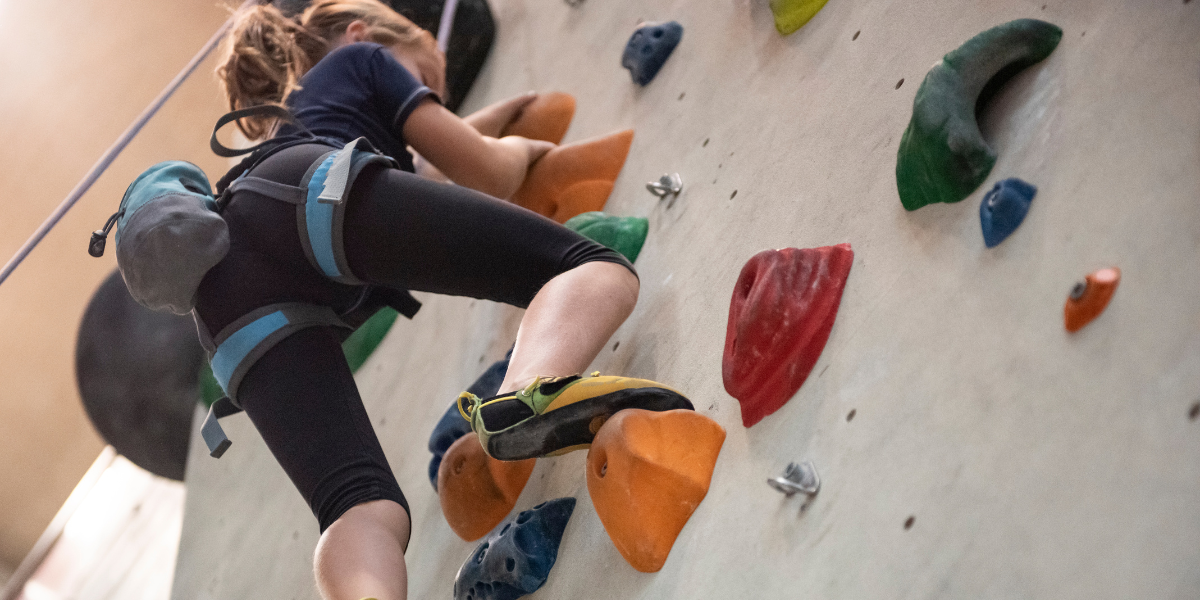You may have seen them in climbing gyms or heard about them, or may even use them - but may not really know what is going on inside these belay systems. Well, we breakdown and break apart the inner workings of an inner belay is this blog post.
What could be better than practicing your climbing sport safely, nothing! First and foremost is fun, that exciting new route, even higher or faster than your last climb. Amazing, and the adrenaline rush you feel! But automatically secured against the risks of one of the most underestimated phenomena on our planet; gravity. After all, you cannot feel, hear, smell or see it, but it is always there.
An Auto Belay Device is an automatic belay device that prevents the slack in the climbing line while the climber climbs up. If the climber reaches the top, or falls, the Auto Belay immediately arrests the fall and lowers the climber to the ground safely and automatically. Thanks to Auto Belays, anyone can climb whenever they want, even without a belay partner. With an Auto Belays, novice climbers can focus on learning climbing techniques and enjoying their sport before they have to master the belay techniques themselves.
What is an auto belay?
An auto belay is an automatic electro-mechanical or mechanical climbing belay system. It replaces the need for a human belayer as the auto-belay automatically retracts the climbing rope, taking up the slack as you climb. Once a climber has reached the top of the wall, the auto belay braking system ensures a smooth descent back to the ground. If you should fall the auto belay slows your descent safely to take you safely to the ground.
Before the climber starts to climb, he attaches himself to the line of the device. While climbing, the rope (lifeline) automatically rolls into the device. After reaching the top and whenever she or he wants to descend or in the event of a fall, the climber descends automatically, at approximately 1 m/s, safely and comfortably.
An auto belay system has the following functions:
- Removes the need for a human belayer
- Retracts rope during ascent
- Controls descent
- Protects against falls
Benefits of an auto belay for climbing
Auto belays are devices that are commonly used in climbing gyms to provide a safe and controlled descent for climbers without the need for a human belayer. These innovative devices have become increasingly popular over the years due to the numerous benefits they offer to climbers and climbing gyms. Here are just a few of the key benefits of using an auto belay in climbing:
- Improved Safety: Auto belays use advanced technology to ensure a safe descent for climbers. They are equipped with sensors that can detect a climber's weight and provide a controlled descent without the need for a human belayer. This eliminates the risk of human error, making auto belays a safer option for climbers of all levels.
- Increased Efficiency: Auto belays allow climbers to climb and descend independently, eliminating the need to wait for a belayer. This not only saves time but also increases the capacity of a climbing gym, as multiple climbers can use the same auto belay at the same time.
- Enhanced Convenience: Auto belays are easy to use and require minimal setup time. They are also available 24/7, making them a convenient option for climbers who want to climb outside of regular operating hours.
- Reduced Labor Costs: By eliminating the need for a human belayer, auto belays can significantly reduce labor costs for climbing gyms. This allows gyms to provide more climbing routes and a better climbing experience for their customers without incurring additional labor costs.
- Improved Climbing Experience: Auto belays provide a smooth and controlled descent, allowing climbers to focus on their climb without worrying about the descent. This results in a more enjoyable and relaxed climbing experience, especially for beginners who may be intimidated by the prospect of using a human belayer.
In conclusion, auto belays offer numerous benefits to climbing gyms and their customers. By providing a safer, more efficient, and convenient climbing experience, auto belays have become a popular choice for climbers of all levels and are an essential component of any modern climbing gym.

What types of Climbing Auto Belay are there?
The hydraulic auto belay is the oldest type of auto belay system and is commonly seen in mobile climbing towers at street fairs and carnivals. This system uses a hydraulic cylinder assembly and a cable which is redirected by pulleys and attached to the climber. If the climber falls, the force is transmitted to the hydraulic piston assembly and oil in the cylinder compresses through a small gap to slow the climber's descent. However, the strong upward pull of the hydraulic auto belays can make it less suitable for experienced climbers.
In contrast, magnetic braking auto belays use high strength magnets and conductive rotors to control a climber's descent. During a climb, a retraction spring takes in the webbing. If a climber falls, the webbing begins to spin and generates tiny electric currents through the drum, creating an eddy current braking phenomenon which slows the fall to a maximum velocity.
Friction braking auto belays also use a retraction spring and a drum brake similar to a car's parking brake to control a climber's descent. The brake uses friction drag to oppose rotation and slows the release of the webbing. However, the high thermal energy inside the device can cause brake fade, resulting in increased descent speeds.
Hydraulic Auto Belays
The oldest type of auto belay system is the hydraulic auto belay. You often see these in mobile climbing towers at street fairs and carnivals. In this system, a hydraulic cylinder assembly is fixed behind the climbing wall and attached to a cable. Pullies redirect the cable up and over to the other side of the wall where it comes down and clips to the climber so that any fall transmits the force to the hydraulic piston assembly. The hydraulic cylinders use an air-over-oil mechanism that creates positive pressure in the assembly, keeping the cable taut as a climber ascends.
The cylinders contain a combination of air and oil. Oil cannot be compressed. If a climber falls, the rope pulls on the chambers forcing the oil to compress through a small gap. The small amount of pressurized air in the chamber allows some movement, but it is very slow. This slow movement in the chambers slows the climber’s rope and lowers them safely to the ground. The pressure in the hydraulic cylinder is also responsible for pulling up the slack on ascension. However, this gives an added ‘assistance’ to a climber. This is something that is helpful for young children climbing, but not great for experienced climbers.
If the climber falls at any point, the force of the climber's fall will create tension on the hydraulic cylinders, pushing hydraulic oil back out of the cylinders through a small fluid flow restriction valve. Since oil is an incompressible fluid, this act of trying to compress the fluid while offering only a small outflow valve is what controls the rate of the climber's descent. Hydraulics take advantage of the relationship between pressure, force, and area. The system has two hydraulic cylinder assemblies.
The strong upward pull-on hydraulic auto belays can be helpful to children getting started, but experienced climbers do not prefer the assistance, and sometimes adults need to pull their kids back down to the ground because the upward pull is so strong. Hydraulic auto belays used in indoor rock-climbing gyms are not portable, and the downsides of the device include the expensive cable replacement, high maintenance, potential for messy fluid leaks, and difficulty of access.
Magnetic Braking Auto Belays
You may have experienced the smooth, repeatable deceleration offered by magnetic braking on roller coasters, trains, and elevators. In a magnetic auto belay, there are two key elements: conductive rotors and high strength magnets. During a climb, a large power spring called a retraction spring takes in the webbing (this is the same mechanism that makes tape measures recoil). If a climber falls on the webbing line at any point, the webbing wrapped around the shaft spins the entire internal assembly, creating a centrifugal force inside the drum. This is where it gets interesting.
Several Neodymium magnets are fixed to the outer edge of the webbing spool drum, which maintain a strong magnetic field at all times. When a climber falls onto the webbing line, the webbing spool begins to spin. Centrifugal force pulls the conductive arms on the rotor into the magnetic field which induces tiny electric currents inside the drum. These unique, circular currents (called Eddy Currents) generate their own magnetic field back onto the spinning rotor arms, which opposes the release of the webbing spool. This eddy current braking phenomenon slows a climber's fall to a maximum velocity, resulting in a smooth, controlled descent1. Coolest part? The magnetic brakes are always engaged and only engage further, proportional to a climber's weight.
Magnetic braking works in a similar way to the brakes on a roller coaster. Instead of using friction - they use an electromagnetic field to control and slow down speed. Its all due to ‘eddy currents’. Basically, if you were to drop a magnet through a plastic tube, it would drop quickly. But drop it through a copper tube, it falls very slowly. That’s because an electromagnetic field has been created around the magnet.
The climbing rope is attached to a retraction spring. When the rope suddenly spins, due to a fall, the magnets kick in and stop the flow.
Friction Braking Auto Belays
Like magnetic auto belays, friction auto belays hang on the top of the wall and use a retraction spring to take in webbing as a climber ascends. Unlike magnetic, a friction auto belay uses a drum brake, similar to a parking brake in a car. Various models of friction auto belays have been made, using either a length of cable or a length of webbing to attach to the climber. If the brake was always active, the webbing would retract very slowly, so these devices typically use a clutch system to disengage the brake during ascent (retraction).
Both magnetic and friction auto belay devices take advantage of the centrifugal force in a spinning drum but in very different ways. In a friction device, the force causes brake shoes to move outward against a metal drum (image above), creating frictional drag that opposes rotation. These brake pads do mechanical work that slows the release of the webbing and control a climber's fall, while also releasing kinetic energy as heat and leaving small dust particles (think what happens when you use a pencil eraser, you get rubber particles and it is sometimes hot to touch).
A downside of friction brakes is that the high thermal energy inside the device causes the braking mechanism to deteriorate (a phenomenon called brake fade, resulting in increased descent speeds during heavy use. A friction brake will deteriorate as the number of cycles increases because the brake dust itself affects the braking mechanism, and the heat also reduces the amount of friction. This is not the case for magnetic, as there are no contacting, sacrificial wear parts that degrade in proportion to the number of climbs, which is why magnetic auto belays are more often used for high throughput facilities. Additionally, if a foreign substance, like water, gets inside of a friction drum brake, it can change the frictional properties and be catastrophic to the brake mechanism.
With friction braking auto belays, the device attaches to the top of a wall. They work in a similar fashion to car brakes. Basically, it’s a drum and inside are a number of plates or ‘shoes’ as they are called. These shoes press against the inner side of the drum creating friction from the centrifugal force generated during descent, thereby lowering the climber at a safe and controlled speed.

What Auto Belay system is right for you?
Any indoor wall operator wants an auto belay to be easily installed, easily accessed, and easily moved. For this reason, indoor hydraulics have become less common. Secondly, an auto belay must be capable of enduring hundreds of climb per day in a high throughput facilities. A magnetic braking auto belay endures cycle after cycle without deterioration of braking performance, while friction devices will inevitably heat up and require the replacing of the brake pads. The magnetic technology works climb after climb, as predictably as your compass points north.
The TRUBLUE Auto Belay is the only auto belay to utilize magnetic eddy current braking technology, which offers benefits in addition to reliability and cyclic endurance. Head Rush's patented magnetic braking mechanism allows each device to adjust to each climber weight and create a consistent descent experience for everyone alike. The more the climber weighs, the more conductive material enters into the magnetic field, the more braking is applied. Thus, the TRUBLUE auto belays are self-regulating, offering the same descent experience to climbers of all weight types.
So now that you know the different types of auto belays and how each works, go out and teach your friends! Perhaps you'll feel better about climbing on auto belays the next time you're running laps at the gym.
Additional expert Information regarding Auto Belay technology and advantages
Interested to read more about the Auto Belay technology and expert opinions?
- Why More FECs Trust TRUBLUE Auto Belays
- TRUBLUE iQ+ World's first catch-and-hold auto belay
- Climbing Walls at FECs: ROI Considerations
- Improve the Accessibility and Inclusivity of Your Climbing Gym
- Catch-and-Hold: What is it and how does it work?
- Climbing on Auto Belay: What You Need to Know
- What is No Delay Belay?
- 7 Ways Magnetic Braking Is Better Than Friction
- A Kid’s Guide to Gym Climbing
- 5 Ways TRUBLUE Can Help a Climbing Gym
- Auto-Belay and hands-free climbing challenges
- Auto Belay for Speed Climbing
- Speed climbing is becoming more popular then ever
- 5 unique ways to use an auto belay
- Auto belay retraction systems white paper













